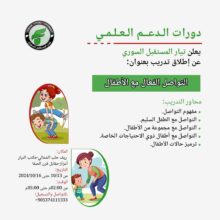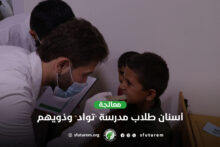Curricula, and the Need for Development

Introduction:
Education is considered a necessity and a crucial tool to combat societal ailments. Additionally, it is a fundamental human right. However, at times, education can become an obstacle, primarily when the curriculum fails to align with current realities or even obstructs reform efforts.
In Syria, both Hafez al-Assad’s regime and later Bashar al-Assad’s aimed to confine the curriculum to Syrian borders, limiting its relevance to broader global advancements. This included teaching medicine in Arabic, unlike many other universities worldwide. This paper provides an overview, without delving into specifics, aiming to capture a general picture of curricula in Syria, particularly in northern Syria, where the Syrian Future Movement (SFM) has established offices. This proximity allows us to better assess and study the current situation.
Current Situation and Challenges:
The education sector in Syria, especially in the northern region, faces significant challenges due to ongoing conflict, displacement, and destruction. These factors directly affect the curriculum, which encounters various challenges and obstacles:
- Multiple Curricula: Northern Syria follows several different curricula, including government curricula, the Self-Administration’s curriculum in the northeast, and UNICEF’s curriculum. This diversity creates difficulties in unifying educational standards and assessing students consistently.
- Resource Shortage: The education sector suffers from a severe lack of financial, human, and educational resources, impacting the quality of education and students’ access to learning materials.
- Teacher Training: Many teachers lack adequate training and qualifications, affecting their ability to deliver effective educational content.
- Infrastructure: Numerous schools have been destroyed or damaged, which negatively impacts the learning environment and makes it challenging for students and teachers to work in suitable conditions.
- Political and Security Changes: Constant political and security shifts create instability and uncertainty, disrupting the education sector.
- Displacement and Homelessness: Displacement has increased the number of students in existing schools, putting further strain on limited resources and affecting education quality.
Specific Challenges Facing the Curriculum:
- The current situation demands that curricula be adapted to meet the conditions and challenges faced by both students and teachers.
- Ensuring the availability of books and necessary teaching materials that align with students’ needs.
- Continuous teacher training programs are essential to enhance their competencies and equip them with the skills needed to address the challenges they face.
- Rehabilitation of damaged schools is necessary to provide a safe and conducive learning environment.
- Psychological and social support is needed for both students and teachers to help them overcome the traumas they have experienced.
Efforts to Improve the Situation:
Despite the significant challenges, efforts are underway to improve the educational situation in northern Syria through:
- Relief Organizations: Several relief organizations provide financial and logistical support to the education sector.
- International Organizations: Many international organizations support education in northern Syria by providing educational materials and teacher training.
- Local Contributions: Local organizations, including the schools affiliated with the Syrian Future Movement (SFM), have contributed to supporting students and teachers, offering alternative learning opportunities.
Raising Educational Standards:
To uplift the educational standards in northern Syria, the following solutions are proposed:
- Curriculum Unification:
- Develop a unified educational curriculum tailored to the needs of students in northern Syria, at least initially, while considering cultural and social diversity.
- Ensure the curriculum is flexible and adaptable to ongoing changes in the region, with a focus on life skills and critical thinking.
- Teacher Training:
- Implement intensive training programs for teachers to develop their educational skills and help them cope with the challenges they face.
- Provide psychological support to teachers to help them recover from the traumas they have experienced.
- Resource Provision:
- Increase financial support for the education sector to provide books, teaching materials, and adequate salaries for teachers.
- Enhance cooperation with international organizations to secure financial and logistical support.
- Rehabilitating Infrastructure:
- Rebuild damaged schools and ensure a safe and suitable learning environment for students.
- Provide schools with essential equipment such as laboratories and teaching aids.
- Vocational Education:
- Link the curriculum to the needs of the labor market to prepare students for practical life.
- Offer students opportunities for practical training in companies and institutions.
- Distance Learning:
- Utilize technology to provide remote learning opportunities for students in hard-to-reach areas.
- Train teachers in using the necessary technical tools for delivering lessons remotely.
- Encouraging Reading and Self-Learning:
- Establish public and school libraries and encourage students to read.
- Provide internet access in schools to facilitate access to information and knowledge.
- Non-Formal Education Programs:
- Organize literacy programs for adults and young people.
- Offer short vocational courses to develop individuals’ skills.
- Community Dialogue:
- Engage the local community in the process of educational development.
- Collaborate with local civil organizations working in education.
By implementing these strategies, Syria, particularly northern Syria, can address the educational challenges and work toward a better future for its students.
Scientific Office Team
Research and Studies Department
Articles
The Syrian Future Movement (SFM)






